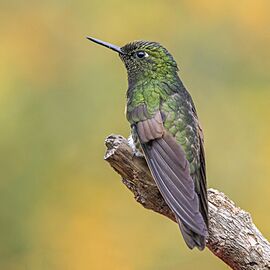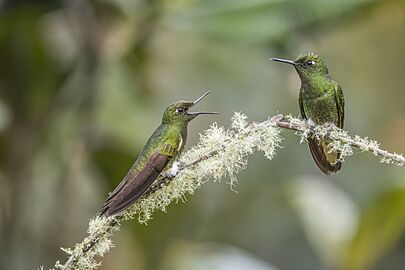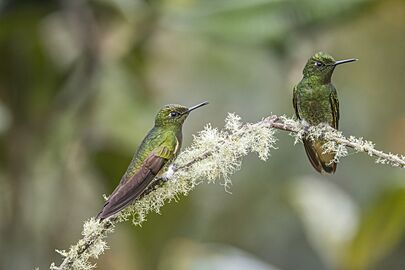Buff-tailed coronet facts for kids
Quick facts for kids Buff-tailed coronet |
|
|---|---|
 |
|
| Boissonneaua flavescens flavescens, Colombia | |
| Conservation status | |
| Scientific classification | |
| Genus: |
Boissonneaua
|
| Species: |
flavescens
|
 |
|
The buff-tailed coronet (Boissonneaua flavescens) is a type of hummingbird. These amazing birds are known for their super-fast wings and love for flower nectar. You can find the buff-tailed coronet living in the mountains of Colombia, Ecuador, and Venezuela. It belongs to a group of hummingbirds called "brilliants."
Contents
About the Buff-tailed Coronet
The buff-tailed coronet is part of a small group of hummingbirds. This group is called Boissonneaua. There are two main types, or subspecies, of the buff-tailed coronet. They are B. f. flavescens and B. f. tinochlora. Think of them like different breeds of a dog. They are the same species but have slight differences.
What Does It Look Like?
The buff-tailed coronet is a small bird. It is about 11 to 12 cm (4.3 to 4.7 in) long. That's roughly the length of a pen! It weighs around 7.3 to 8.8 g (0.26 to 0.31 oz). This is lighter than a few paper clips. Both male and female birds have a short, straight, black beak. They also have a small white spot right behind their eye.
Male birds of the main subspecies are mostly shiny green. Their belly is a buff color with green spots. When they fly, you can see their cinnamon-colored feathers under their wings. Their central tail feathers are bronze. The other tail feathers are buff with bronze tips and edges. They even have tiny white tufts on their legs! Female birds of this subspecies have more buff on their bellies. The bronze on their tail is also less widespread. The other subspecies, B. f. tinochlora, has a cinnamon tint to its buff parts. It also has more bronze on the tips of its tail feathers.
Where Does It Live?
The main subspecies of the buff-tailed coronet lives in the Andes mountains. You can find it from western Venezuela down through all three mountain ranges in Colombia. The other subspecies, B. f. tinochlora, lives in southwestern Colombia. It also lives south along the western side of the Andes in Ecuador. It can be found in a few spots on Ecuador's eastern Andean slope too.
These hummingbirds like to live inside and on the edges of humid forests. They enjoy cloudforests and elfin forests. These are forests that are often covered in clouds or mist. They can also be found in more open areas with shrubs. They typically live at high elevations. This is usually from 2,000 to 3,500 m (6,600 to 11,500 ft) above sea level.
How Does It Behave?
Movement
The buff-tailed coronet does not travel far. It stays in the same area all year round. Scientists call this "sedentary."
Feeding Habits
This hummingbird is very protective of its feeding spots. It will defend its territory. However, it might share a flowering tree with other hummingbirds. It usually looks for food in the middle part of the forest. But it also feeds at the very top of the trees. Its main food is nectar from certain flowers. These include flowers from the Cavendishia, Palicourea, Disterigma, and Huilaea plant groups.
When it feeds, it often clings to the flower. It holds its wings open for a second or two after landing. Besides nectar, it also catches small insects. It does this by "hawking." This means it waits on a perch and then flies out to catch insects in the air.
Breeding
Buff-tailed coronets have been seen breeding between November and March. They build a cup-shaped nest. It is made of moss and lichen. The nest is usually attached to a branch. It is typically between 3 and 10 m (10 and 30 ft) above the ground. The female bird sits on the two eggs to keep them warm until they hatch.
Sounds and Calls
What is believed to be the buff-tailed coronet's song is a continuous series of high-pitched "tsit" notes. Sometimes, several of these birds will sing together nearby. They also make a "squeaky twittering" sound. This includes rising piping notes and stuttering rattles. They often make these sounds when they are interacting with other hummingbirds.
Status and Protection
The IUCN (International Union for Conservation of Nature) has looked at the buff-tailed coronet. They have listed it as "Least Concern." This means that it is not currently at risk of disappearing. We don't know exactly how many of these birds there are. We also don't know if their numbers are growing or shrinking. No immediate dangers have been found for them. The bird is considered rare in some areas. But it is common in other parts of its large range. It lives in at least one protected area in Colombia.






